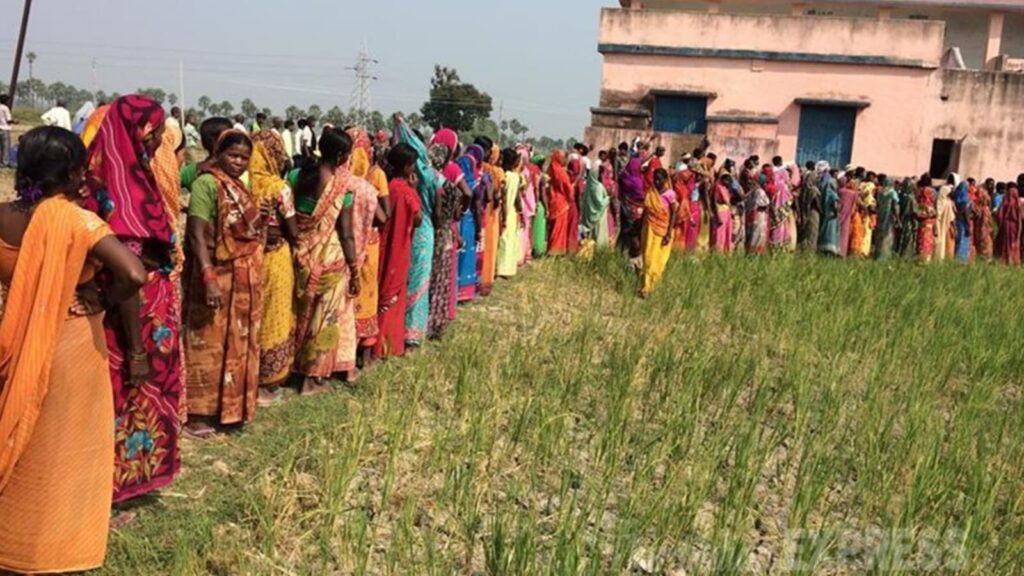Though more women than men have been turning up to vote in Bihar in the last few elections, women’s representation in the elections as well as in the Assembly has remained low, shows an analysis of the past five state elections.
In the February 2005 Assembly elections, the first after Jharkhand was carved out of Bihar, 234 women contested the polls, of whom 24 made it to the Assembly. The state went to the polls months later in October, but only 138 women were in the fray. Twenty-five women made it to the Assembly in that election.
In 2010, the House saw the number of women increase to 34 (307 women had contested). Of them, 22 were JD(U) MLAs, while 11 came from the BJP. The Assembly also had one Independent woman legislator.
Five years later, the state saw a dip in both the number of women contesting and winning the Assembly polls. While 273 women entered the fray, only 28 managed to win, with a majority of them from the JD(U) and the RJD, which contested the elections in an alliance. Both parties fielded 10 women candidates each. While all of RJD’s women contestants won, nine women MLAs from the JD(U) were elected. Four of the 14 women the BJP fielded won the polls. The Congress, too, put up an impressive show, with four of its five women contestants winning.
In the 2020 Assembly polls, women’s representation declined as only 26 of the 370 women candidates made it to the House. The BJP fielded 13 women candidates, while its ally JD(U) nominated 22, of whom nine and six, respectively, tasted victory. The lone woman candidate fielded by Mukesh Sahani’s Vikassheel Insaan Party (VIP), then an NDA partner, won the polls, as did the sole woman nominee of the Jitan Ram Manjhi-led Hindustani Awam Morcha (Secular).
From the Opposition Mahagathbandhan, the RJD and the Congress fielded 16 and seven women candidates, respectively. While seven of the RJD’s nominees won, two from the Congress made it to the Assembly. Other women candidates — 22 from the Lok Janshakti Party (then undivided), 10 from Upendra Kushwaha’s Rashtriya Lok Samta Party (now Rashtriya Lok Morcha), seven from the Bahujan Samaj Party (BSP), and three each from the AIMIM and Jharkhand Mukti Morcha (JMM) — lost the polls.
Coming polls and major parties
For next month’s elections, the NDA has fielded 34 women, while the Mahagathbandhan has given tickets to 30. Both the BJP and JD(U) have fielded 13 women each, while Chirag’s LJP (Ram Vilas) has given tickets to five. The HAM(S) has fielded two women and the RLM one.
The RJD has given tickets to 24 women, but the nomination paper of Shweta Suman from Mohania in Kaimur district was rejected. The Congress has fielded five women, while the CPI (M-L) Liberation and the VIP have nominated one woman each.
The BSP, which is contesting 130 seats, has fielded 26 women, while Jan Suraaj has fielded 25 women.
Dr Nirmala Kumari, the Head of the Department of Political Science at Bodh Gaya’s Magadh University, said political parties’ reluctance to field women was a key reason for their low representation in the Assembly. “Parties have dedicated women’s wings and women leaders who work hard on the ground. But instead of giving them tickets, they prefer fielding turncoats and outsiders. Even in the coming polls, most of the women candidates have been fielded as they are sitting MLAs,” she said.
Why women voters are crucial
In the past three elections, the turnout of women voters has been higher than that of men. In 2020, 59.69% of women voters cast their vote, while only 54.45% of men did. The gap was higher in 2015, with women voters recording a 60.48% turnout as against 53.32% for men. In 2010, 54.49% of women voted, as against 51.12% of men.
With more women voting, the Nitish Kumar government has implemented targeted women-centric schemes in its two decades in power, such as 50% reservation in panchayats, free bicycles, and Prohibition.
“Nitish’s strength is his caste-neutral constituency of women voters, which he has consolidated through the formation of 11 lakh self-help groups, 1.4 crore Jeevika workers and Rs 10,000 aid to 1.21 crore women entrepreneurs. (RJD leader) Tejashwi (Yadav) envies this voter bloc Nitish has very meticulously cultivated,” said a JD(U) leader.
Tejashwi too has been trying to reach out to women voters in the run-up to the elections. Last week, he announced a slew of measures for Jeevika workers — rural women who are part of the Bihar Rural Livelihoods Project that is also known as Jeevika — including an interest-free loan for two years. His other announcements include the MAA (Makaan, Anna and Aamdani) and BETI (Benefit, Education, Training, Income) schemes, both follow-ups to the Mahagathbandhan’s proposed Mai Bahin Maan Yojana that promises monthly assistance of Rs 2,500 to economically disadvantaged women.

